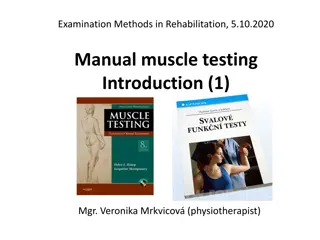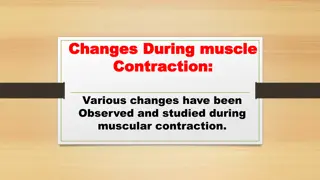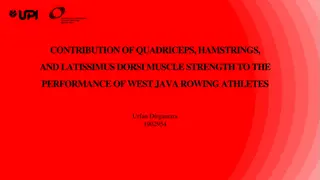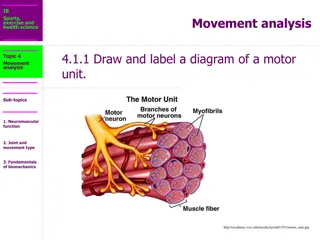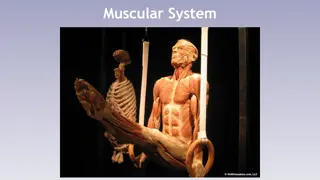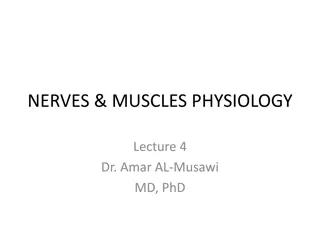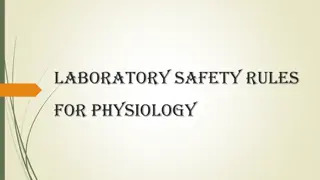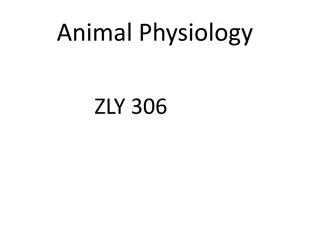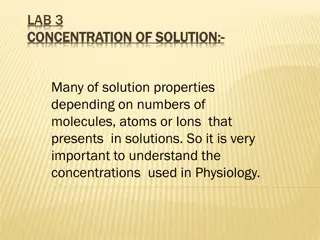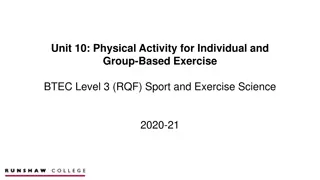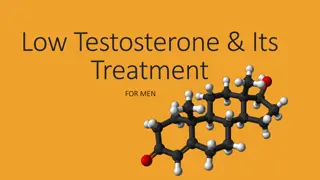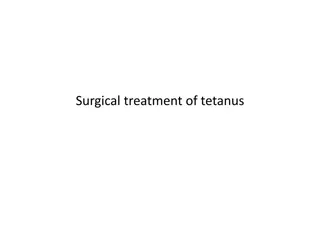Understanding Types of Muscle Actions in Physiology
Explore different types of muscle actions, including isometric contractions, isotonic contractions, concentric contractions, eccentric contractions, isokinetic contractions, and iso-inertial contractions. Each type plays a crucial role in muscle function and movement, with varying effects on muscle length and strength. Understanding these actions is essential for optimizing workout routines and physical therapy interventions.
Download Presentation

Please find below an Image/Link to download the presentation.
The content on the website is provided AS IS for your information and personal use only. It may not be sold, licensed, or shared on other websites without obtaining consent from the author. Download presentation by click this link. If you encounter any issues during the download, it is possible that the publisher has removed the file from their server.
E N D
Presentation Transcript
TYPES OF MUSCLE TYPES OF MUSCLE ACTIONS ACTIONS BY: DR. DIGVIJAY SHARMA DIRECTOR SCHOOL OF HEALTH SCIENCES, CSJMU
TYPES OF MUSCLE ACTIONS TYPES OF MUSCLE ACTIONS Muscle actions or muscular contractions are broadly divided into following types: Isometric contractions or constant length Isotonic contractions Concentric contractions Eccentric contractions Isokinetic contractions Iso-inertial contractions
Isometric contractions Isometric contractions When both the distal and proximal attachments of a muscle are fixed and the torque produced by a muscle is equal to the torque of the resistances, the visible muscle length will remain unchanged although shortening of muscle occurs at the myofibril level. When there is no visible change in the joint angle, the muscle action is called an Isometric contraction No mechanical work is done in an isometric contraction because the Force (F) has not moved the lever through a distance (d). However, energy is being expended to produce cross bridge cycling
Isotonic contractions Isotonic contractions It refers to the equal or constant tension in muscle through out the range of motion, which is unphysiological so the term is not commonly used.
concentric contractions concentric contractions When muscle attached to bones are free to move and the force generated by the muscle can produce torque sufficient to overcome the load, then the muscle will undergo a shortening or concentric contraction Both the bones will be pulled towards each other and towards the centre of the muscle usually during functional activity One attachment of a muscle is stabilized and the other attachment is free to move. So if the proximal is fixed the distal bony component and if the distal is fixed the proximal bony component moves During this contraction, work is done by muscle as the muscle move the bony lever through a distance in the direction of the muscle pull. So, W= F d
eccentric contractions eccentric contractions When the force and resulting torque that a muscle generates is insufficient to affect an opposing torque on a lever, the muscle will undergo lengthening or eccentric contraction In this activity, the two ends of the muscle move apart or away from each other The mechanical work that is done by a muscle during eccentric contraction is called negative work because work is done on the muscle rather than by the muscle The energy consumption is comparatively lesser than concentric contraction When equal loads are used because fewer motor units are being activated in an eccentric contraction than a concentric contraction In this type of contraction muscle acts as a brake as if attempts to control the movement at bony component while lever moves in opposite direction to eccentric muscle pull
Isokinetic contractions Isokinetic contractions In this the angular velocity of the bony compartment is present and kept constant by a mechanical device throughout a joint ROM To maintain a constant velocity the resistance produced by the device is directly proportional to the torque produced by the muscle at all points in the ROM Hence as the torque produced by the muscle increases the magnitude of the resistance increases This may be done by using devices such as Biodex, Cybex, KINCOM, Orthotron, etc The advantage of isokinetic exercise over the weight lifting is that the isokinetic exercises accommodate for the changing torque created by the muscle throughout range of motion Throughout the ROM this equipment is used for determining amount of torque that a muscle can develop at different velocities, for strength training and for comparing the relative strength of one muscle group with another
Iso Iso- -inertial contractions inertial contractions It has been designed to quantify dynamic muscle work It is defined as a type of muscle action in which muscles act against a constant load or resistance and the measured torque is determined while the constant load is accelerating or decelerating It is thought to be more closely mimic the normal joint function than isokinetic testing and exercising Is the torque produced by the muscle is equal to the resistance, the muscle contracts isometrically If the torque produced by the muscle is greater than the resistance, the muscle shortens and contracts concentrically Conversely, if the torque produced by the muscle is less than the resistance, the muscle will contract eccentrically The advantage of both isokinetic and iso-inertial devices are that they are capable of quantifying muscle activity
Angular velocity and torque Angular velocity and torque When a bony component moves around a joint axis The rate of change of position of the bony component is referred to as its rotational or angular velocity The angular velocity of a bony lever during dynamic muscle contraction is a function of the magnitude of the net torque applied to the lever When total muscle force (fms) and quantity or an external load (Fext) or both applied in opposite directions, the net torque can be calculated by: Net Torque= (Fms MA) (Fext MA) In case of concentric contraction the net torque is the positive while negative in case of eccentric while 0 in case of isometric contraction


